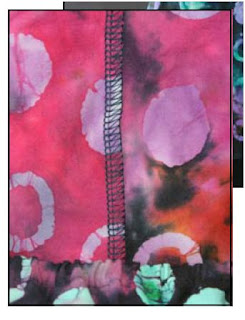Like Jess, I can tell you I am extremely intimidated by sewing with a serger. I'm fairly comfortable sewing with a basic machine but deciding to jump into a project with my serger was entirely out of my element. I'm a big planner and I feel relatively okay doing new things with the wealth of information you can gain by spending a few hours online. Learning the serger has not been so easy. I want to say I read the manual and then immediately started sewing but that wasn't the case.Before I get to an actual project I thought it would be helpful to explain the basic functions of a serger. As you may already know, I received my serger as a birthday gift. My mom bought me a Singer Professional 5 that came with 6 additional presser feet.
I was excited and then instantly thought, "wait, what can I do with a serger?"
After a lot of reading and no sewing (yet), I think I know what my serger can do.
Double Chain Stitch
also used for decorative chainstitch topstitching effect
 |
| Double Chain Stitch |
Two-thread wrapped Edge Overlock (narrow)
Two-thread Overedge (narrow and wide)
used as a lightweight seam finish or a lightweight seam
less thread is used and does not imprint on the right side of fabric when pressed
creates less bulky seams (ideal for sheer or lace fabrics)
 |
| Two-thread Overedge (narrow and wide) |
Three-thread Overlock (narrow)
most commonly used because of its versatility
provides professional seam finish to woven fabrics
beneficial in preventing loosely woven fabrics from unraveling
offers unlimited decorative capabilities
recommended for finishing seams but not reinforcing the seam
 |
| Three-thread Overlock (narrow) |
Three-thread Flatlock (narrow and wide)
also used to serge non-bulky seams
 |
| Three-thread Flatlock (narrow) |
 |
| Three-thread Flatlock (narrow) |
 |
| Three-thread Flatlock (narrow) |
Three-thread Ultra Stretch Mock Safety
- stretches with the fabric, seam will not break when fabric is stretched
- ideal for super-stretch knits like those used on swimwear or athletic clothing
 |
| Three-thread Ultra Stretch Mock Safety |
Four-thread Ultra Stretch Mock Safety
stronger than the Three-thread Ultra Stretch Mock Safety stitch
the additional thread provided added strength to the seam (good choice for knits and wovens)
works well when applying ribbing to garment (often seen on cuffs, collars, and waistbands)
 |
Four-thread Ultra Stretch Mock Safety
|
Four-thread Safety Stitch
alternative to the Five-thread Safety Stitch
offers same type of Two-thread Chainstitch
used when sewing a medium weight woven fabric because the stitch is less bulky
 |
Four-thread Safety Stitch
|
Five-thread Safety Stitch (wide)
- combination of a Two-thread Chainstitch and Three-thread Overlock stitch
- Suitable for woven fabrics and provides a durable seam for heavy weight fabrics (denim)
.JPG) |
| Five-thread Safety Stitch (wide) |
Five-thread Safety Stitch (narrow)
- same benefits as Five-thread Safety Stitch (wide)
.JPG) |
| Five-thread Safety Stitch (narrow) |
Cover Stitch (narrow)
- often seen in ready to wear garments
- two needles crate parallel rows of topstitching and one looper sews an edge finish on underside
.JPG) |
| Cover Stitch (narrow) |
Cover Stitch (wide)
same benefits as Cover Stitch (narrow)
.JPG) |
| Cover Stitch (wide) |
Triple Cover Hem
professional and creative triple topstitch
three needles create parallel rows of topstitching and one looper sews an edge finish on underside
ideal for heavier fabrics
traditionally used in home decorating
adds unique accent for garment constructions
 |
| Triple Cover Hem |
Three-thread Rolled Hem
used to finish edges of scarves, ruffles, table linens, and some garments
suitable for lightweight to medium weight fabrics
used for pintucks
 |
| Three-thread Rolled Hem |
My serger came with a beading foot (used for sewing on beads, sequins, pearls, and thick cord), a blind hem foot(used for hemming skirts, paints, and other sewing projects in one easy operation), a cording foot (used for sewing piping betwe3en two layers of fabric in one easy operation), an elastic foot (used for inserting elastic into a seam), ashirring foot (used for shirring and gathering), and a taping foot (used for inserting a tape into seams that will stretch easily).
No comments:
Post a Comment